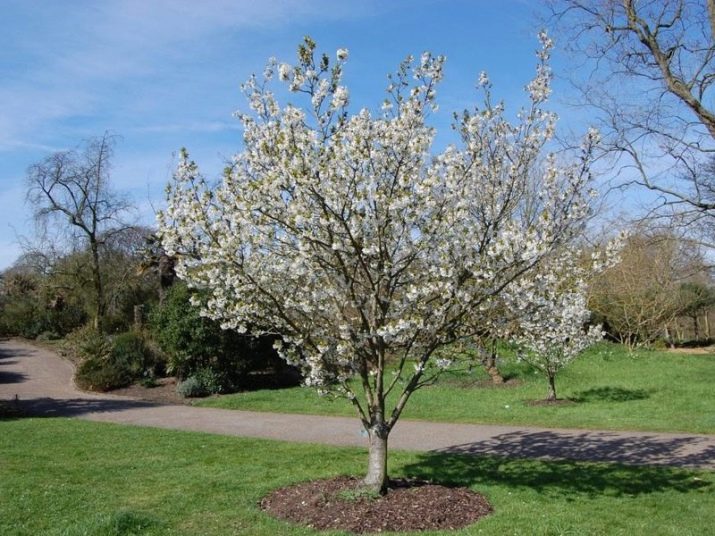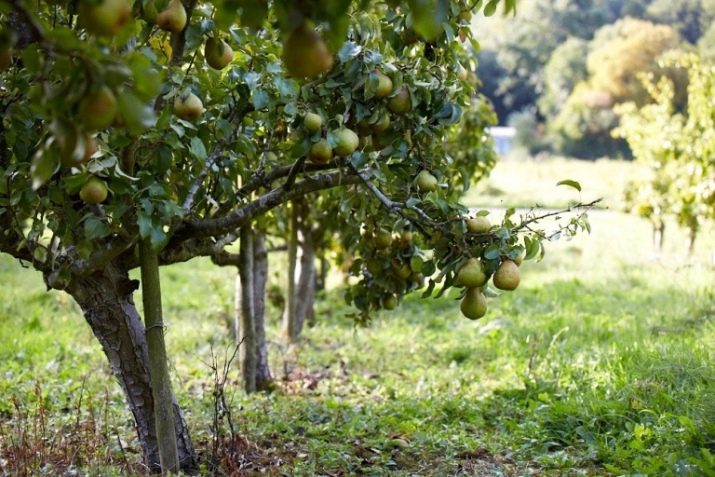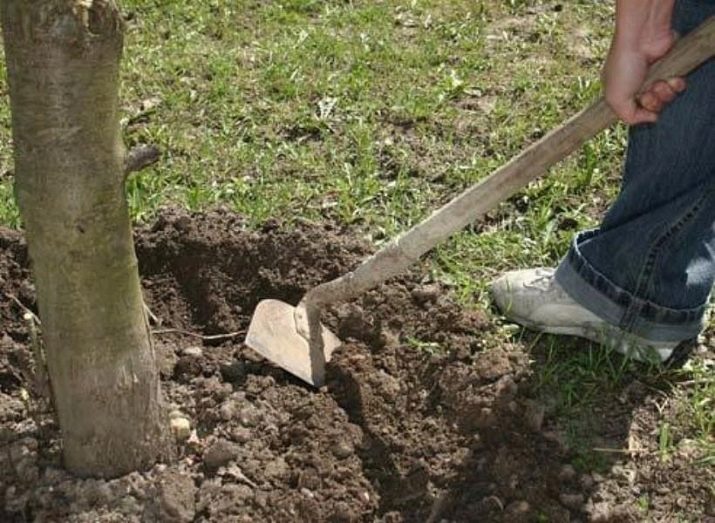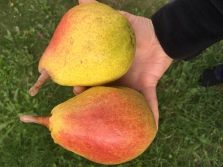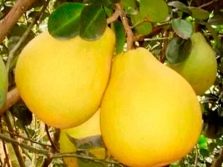Why does not pear flower and fruit not?
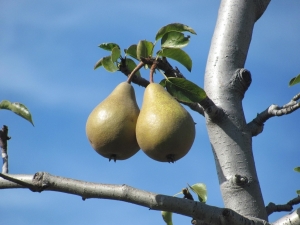
There are quite a few factors that prevent pear fruit production, but in order to prevent them, you need to be familiar with the root of the problem. Botany refers pear tree to the class of dicots, flowering department, pink family. The maximum height of the plant is 20-25 meters, with a crown diameter of up to five meters. To date, there are over four and a half thousand varieties of pear tree. Some plants live more than two hundred years.
The average yield that can be harvested from one hectare is close to five tons of fruit. The maximum yield collected from one plant, has one ton of pears. In addition to the variety of varieties, there are different types of pear trees - at the moment their number is approaching thirty-three. Categories such as the safety and timing of harvesting, classify pear in the summer, autumn and winter.
Pear Tree Features
Often the reason that a pear does not produce fruit is simply the age of the tree. As a rule, a pear tree seedling planted in open ground begins to bear fruit in the fifth to eighth year. A large role is played by the plant variety of your choice, because there are varieties that begin to bear fruit only in the twelfth or fifteenth year after planting. The earliest pear varieties are “Memory of Yakovlev”, “Anna”, “Chizhovsky” and “Honey”.
The most recent periods of fruiting are the fruits of "Limonka", "Favorite" and "Bessemyanki." Experienced gardeners claim that the period during which a pear is able to bear fruit is approximately sixty to seventy years. However, there were cases when the plant yield did not stop for 110–140 years. It should be noted that the average volume of pears collected from one tree during his life was four to five tons.
The yield of pears largely depends on the correctness of the care of the plant. Planting different varieties of pears should be at a distance of three to four meters from each other. At the same time the distance between pear trees should not be more than thirty meters, otherwise the plants will not be able to pollinate each other.
If pears are not tied after reaching 5 years for two seasons or more (especially if there has already been fruiting before), then something needs to be done, and our recommendations will help.
Factors affecting fruiting pears
The pear, being a rather impartial and unpretentious plant in the care, which does not require any specific conditions for cultivation, still responds favorably to the fertile soil, good illumination of the cultivation area and loose soil that allows the tree to "breathe" and let the excess moisture in well. Consequently, the presence of adverse conditions can significantly affect the fruiting pears. So, we turn to the main reasons for the lack of fruiting in this culture.
An experienced gardener is certainly aware that the pear tree itself is barren. In other words, The pear needs to be cross-pollinated - this is because the pear tree's own pollen is not suitable for ovaries. In this regard, it is recommended to grow from two to three varieties of this plant in the garden plot. The only thing that should be taken into account when planning a garden - the time of ripening of trees should coincide. However, this issue is solved by grafting a branch of one tree to another.
Freezing or a sharp change in temperature is detrimental to the active growth and fruiting of pears. It is recommended to get acquainted with the influence of cold weather on different parts of the pear tree. For example, in the early spring, the pear bud and ovary are fragile as never before. In this regard, when choosing a sapling, do not give preference to the southern variety, as this will require additional care and carefully thought-out protective measures - for example, the construction of a kind of greenhouse that can maintain an appropriate temperature inside.
It is no secret that snow is a natural insulation, but it does not fall on a schedule. As a rule, by the beginning of winter, when the temperature is already quite low, he does not have time to fall out, which contributes to the death of the root system of the plant in cold soil.In order to avoid such a situation, it is recommended to immediately engage in the insulation of the root system of pears. Leaves, tree branches or needles are used as a warming material.
Winter provokes another unpleasant process - breaking the bark. The damaged area will need to cover up with clay and garden pitch or wrap with natural cloth. The presence of a cold northerly wind will impede the active growth of the pear tree, therefore, the plant should be planted in a fairly protected place. This may be a fence or wall section.
The lack of light is another adverse factor for this plant, which significantly affects the yield. In this regard, the choice of location should be determined not only by protection from the north winds, but also the presence of the required amount of light. One of the factors reducing fruit bearing or its complete absence is the incorrect planting of seedlings in the ground. Few people know, but the correct position of the root neck of a pear tree is flush with the surface of the earth.
Excessively high location of the root collar should be accompanied by regular hilling, low location, on the contrary, requires the removal of excess soil.
This plant, regardless of the variety, does not tolerate transplantation. Particular attention should be paid to a large seedling. If there is no urgent need, refrain from transplanting. If transplantation is still necessary, make sure that the plant receives the necessary amount of fertilizer, water, light and heat. If you have followed all the recommendations, but the situation with the fruiting of the pear tree has not been corrected, there can be only one reason for this - the plant variety. It is likely that a fairly common variety of pears grow on your site, which tend to bear fruit only on the tenth year of planting in open ground. It is not given to the gardener to fix this - except to plant a tree for another variety.
The real misfortune for the plant are harmful insects. For a pear tree, the most dangerous enemy is the sucker. In the early spring, it eats the buds of the plant, thereby excluding the possibility of pear tree flowering. No less dangerous enemies are apple flower beetles and moths, who love to eat pear leaves. In turn, these parasites infect the plant with a fungal disease. Determine that a pear is infected, can be on the leaves, which appeared dark spots.
It is recommended to systematically process the pear tree with a sprayer with a specialized preparation, for example, chlorophos and karbofos.
Lean on trace elements and vitamins, the soil adversely affects the yield of pears. The problem of nitrogen deficiency can solve the introduction of manure. Enrichment of soil with phosphorus and potassium will also help to correct the problem of fruiting. But do not overdo it, because the balance is needed in everything, and the soil oversaturated with vitamins and nutrients will definitely favor the growth of the pear tree, but not the fruits, but the branches and leaves. As a result, the crown of the plant becomes excessively thick, and this requires the plant to waste a large amount of energy, and the carrying of the fruits fades into the background.
Fruits, as a rule, first decrease in size, then their number decreases. To avoid such problems, it is recommended that pear tree crown be regularly pruned. It is advisable to cut a young shoot growing to the center of the plant. The branch that stretches towards the sun will need to be bent down and secured in a horizontal position.
The last but no less important factors affecting the fruiting of pears are the level of acid in the soil and the moisture content of the soil. For land with elevated acid levels, liming is required. In the presence of excessively high groundwater, the root system of the pear tree will inevitably begin to rot.Be scrupulous and attentive in choosing a site for planting seedlings.
Recommendations for non-fertile pears
Having corrected the above factors that prevent the pear tree from fruiting, it is likely that you will correct the situation. However, there are a few more recommendations that can help you.
- Regular loosening of the soil next to a pear tree promotes the entry of a large amount of oxygen. Oxygen starvation is contraindicated for this plant, but obtaining the required amount will provoke good fruiting.
- Despite the fact that the pear is a non-capricious culture and is a rather drought-resistant plant, it is recommended to additionally supply the plant with water in the dry summer period.
- To provoke and intensify the growth of fruits, it will be necessary to feed the plant with manure, compost or minerals. An excellent option is to combine feeding and loosening. For one pear tree, you need only five kilograms of fertilizer once every twenty-four months and fifty grams of phosphorus-containing feed.
Varietal pear tree feature
As noted earlier, the lack of flowering in the plant may depend on the characteristics of the variety. Below are the most common varieties of pears and their fruiting period:
- "Anna" - a variety with early fruits, in the first – second year after planting;
- "Honey", "Moldavian Early", "Noyabrsky", "Petrovsky", "Pushkinsky" - varieties that bear fruit only in the third or fourth year after planting in open ground;
- "Veleska", "Williams", "Duchess", "Veronica", "Rossoshansky Late", "Early", "Fairytale", "Treasury" - varieties that will give a juicy and bountiful harvest only in the fifth to seventh year after landing in open ground.
- "Bere Bosk", "Vika", "Forest Beauty" begin to bear fruit only in the sixth to seventh year after disembarking;
- "Bergamot", "Limonica", "Favorite" bear fruit in the seventh or eighth year after disembarking;
- "Bessemyanka" bears fruit from the eighth to the ninth year.
However, experienced gardeners argue that it is impossible to give an unequivocal answer to the question of when to wait for fruits from a pear tree. Varietal features are very diverse and the period of the first fruiting can take up to ten or fifty years.
It should be noted that after the fruiting period is over, the pear tree instantly dies.
See why the pear does not bloom and bear fruit, see the next video.

